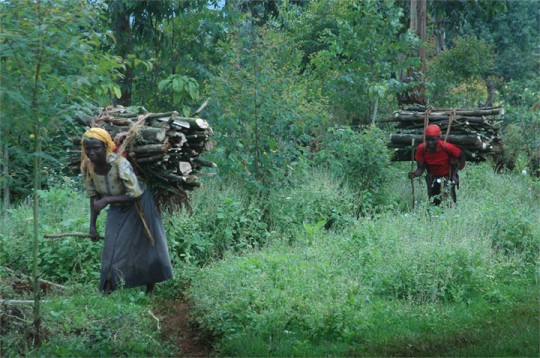Forests can feed world’s hungry and over-exploitation for timber must be curbed – UN
Forests can feed world’s hungry and over-exploitation for timber must be curbed – UN
26 October 2011
With 1 billion people suffering from chronic hunger, the role of forests for timber must not overshadow their important contribution to feeding many of the world’s poorest communities, and their over-exploitation for wood must be curbed, according to the Collaborative Partnership on Forests (CPF), a 14-member group which includes several UN agencies.
“Forests and trees on farms are a direct source of food and cash income for more than a billion of the world’s poorest people,” Food and Agriculture Organization (FAO) Assistant Director-General for Forestry Eduardo Rojas-Briales said.
“They provide both staple foods and supplemental foods. To enhance these benefits, governments and development partners should increase investments in support of sustainable forest management and rehabilitation of degraded forest lands,” he added, noting that in India, more than 50 million people depend directly on forests for subsistence, while in Laos wild foods are consumed by 80 per cent of its 6.4 million people on a daily basis.
Forest foods and wild animals form a small but critical contribution to otherwise bland and nutritionally poor diets of rural people. Wild leaves can be an excellent source of vitamins A and C, protein and micronutrients such as calcium and iron, fruits are especially rich in minerals and vitamins and contribute significant quantities of calories, while a variety of forest plants have edible roots and tubers, which provide carbohydrates and minerals.
But forest-dependent wildlife and forest foods are increasingly threatened by over-exploitation in many developing countries, causing biodiversity loss and putting food security at risk.
Women also play an important part in processing tree and forest products, the income from which helps their families achieve food security. For instance, women use shea butter, extracted from the nut of the shea tree, as a cooking fat and food accompaniment in West Africa. The harvesting and processing of shea, which is an important ingredient in chocolate and other confectionery, provides rural women with nearly 80 per cent of their income.
Apart from FAO, the CPF includes the UN Development Programme (UNDP), the UN Environmental Programme (UNEP), the UN Framework Convention on Climate Change (UNFCCC), the UN Convention to Combat Desertification (UNCCD), and the UN-backed on Biological Diversity (CBD).
Other members include the Centre for International Forestry Research (CIFOR), the International Tropical Timber Organization (ITTO), the International Union for Conservation of Nature (IUCN) and the World Agroforestry Centre (ICRAF).
###
> UN Food and Agriculture Organization (FAO).
The Food and Agriculture Organization of the United Nations (FAO) is an intergovernmental organization and has 191 Member Nations, two associate members and one member organization, the European Union. Achieving food security for all is at the heart of FAO’s efforts – to make sure people have regular access to enough high-quality food to lead active, healthy lives.

FAO’s mandate is to raise levels of nutrition, improve agricultural productivity, better the lives of rural populations and contribute to the growth of the world economy.
The Food and Agriculture Organization of the United Nations (FAO) is working with its Members and the entire international community for achievement of the Millennium Development Goals.
These eight goals – each with specific targets and indicators – are based on the United Nations Millennium Declaration, signed by world leaders in September 2000. They commit the international community to combating poverty, hunger, disease, illiteracy, environmental degradation, and discrimination against women.
![]()
The eight Millennium Development Goals are:
Goal 1: Eradicate extreme poverty and hunger
Goal 2: Achieve universal primary education
Goal 3: Promote gender equality and empower women
Goal 4: Reduce child mortality
Goal 5: Improve maternal health
Goal 6: Combat HIV/AIDS, malaria and other diseases
Goal 7: Ensure environmental sustainability
Goal 8: Develop a Global Partnership for Development
* More information at UN Food and Agriculture Organization (FAO)
###
###
> United Nations (UN).
 The United Nations was established on 24 October 1945 by 51 countries committed to preserving peace through international cooperation and collective security. Today, nearly every nation in the world belongs to the UN: membership totals 192 countries.
The United Nations was established on 24 October 1945 by 51 countries committed to preserving peace through international cooperation and collective security. Today, nearly every nation in the world belongs to the UN: membership totals 192 countries.
When States become Members of the United Nations, they agree to accept the obligations of the UN Charter, an international treaty that sets out basic principles of international relations. According to the Charter, the UN has four purposes:
- to maintain international peace and security;
- to develop friendly relations among nations;
- to cooperate in solving international problems and in promoting respect for human rights;
- and to be a centre for harmonizing the actions of nations.
###
* The above story is adapted from materials provided by United Nations (UN)
** More information at United Nations (UN)






















